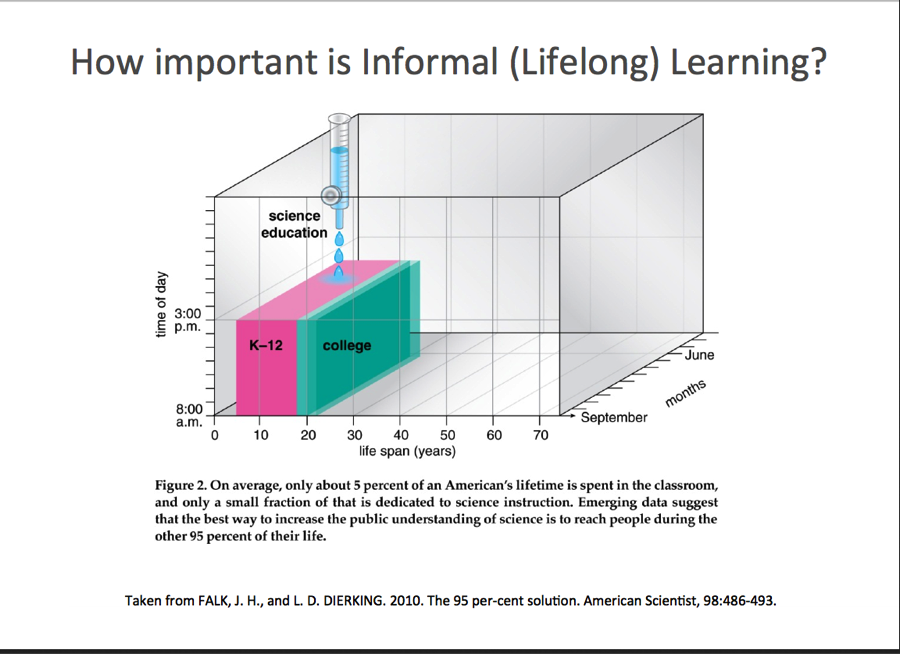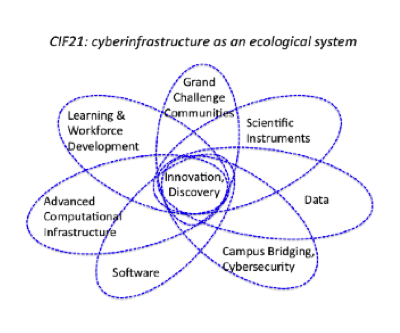This article was generated from a webinar presented as an addendum to the iDigBio Education & Outreach Workshop held in Gainesville, FL, January 15-17, 2014. Participants were interested in finding out more about applying for grants available through the National Science Foundation (NSF) for Education and Outreach.
If you are targeting the National Science Foundation (NSF) for Education and Outreach funding, you may be looking for money in all the wrong places. With creativity and knowledge you can find the right places.
The Black Box called NSF is the primary place to fund basic STEM research. NSF employs about 2000 people, with a budget of around $7 Billion. It receives somewhere between 45 to 50 thousand proposals each year of which approximately ten thousand are funded. It is a competitive place to seek grant money. Most researchers find their “comfort zone” for proposals under the directorates of Research & Related Activities (R&RA). But with a 20% acceptance rate, you need to think outside the box.
Consider that only 5% of an American’s lifetime opportunities to learn take place in the classroom environment – learning K-12 or K-16. Ninety-five percent of our learning occurs outside of formal settings. Museums, science centers, science cafes, and documentaries are some of many venues that engage life long learners.

A mother and daughter enjoying exhibits like a megladon shark exhibit at a museum of natural history is not only a wonderful way for science to reach out to society but also an important reinforcement of the broader impact of scientific activities. Now you’re starting to think out side the box!
Lets look inside NSF for clues to a successful proposal.
As in all fields, there are trends in the funding world too. The past years have seen a decline of core single-investigator NSF awards and the rise of complex collaborative projects. Projects that are multi-disciplinary have broad impacts, and international cooperation are currently attractive. The concept of crosscutting several areas of endeavor is a natural “best-practices” outgrowth. When NSF makes large investments, the preference for collaborative trending allows leveraging of resources, making the investment work in a variety of ways. In terms of infrastructure, if the projects have good prospects for environmental sustainability as well sustainable longevity, that’s a desirable plus.
In addition to multi-disciplinary and sustainable, you can find clues to a successful proposal in concepts that come in waves of “buzz words”. Trending now are “climate change”, “sustainability”, “Big Data”, “collaborative learning”, “underrepresented minorities”, “integrated graduated training”, and “community of practice”. Jump on the bandwagon while you can. The focus may change rapidly. See what’s trending and fit what you are doing into these strategic initiatives.
If in doubt, follow the money. A look at the budget will clearly show priorities.
Consider Education and Human Resources (HER). In 2013 HER captured about 1/8 of the total budget of NSF. Some program options within EHR worth investigating are: DUE (Division of Undergraduate Education); DGE (Division of Graduate Education); HRD (Human Resource Development); DRL (Division of Research on Learning); DRK12 (Discovery Research K12); AISL (Advancing Informal STEM Learning).
Are there opportunities? Yes. But be aware, you are dealing with a different culture. If your comfort zone has been in BIO or GEO, you need to think about repackaging your proposal.
It’s never the case that a proposal you submitted for BIO, or GEO or another R&RA program will be accepted verbatim as a re-submit. You are going to have to frame it in a totally different way. Decide what you want to accomplish and frame your project in terms of benefits for students or teachers, or life long learners. Think about opportunities for advancing informal STEM learning. Be innovative about the way you present your concepts.
Think in terms of Thematic Collections Networks, integrated graduated training, benefits to underrepresented minorities or assisting and inspiring young faculty.
Some recently successful applications include networking professional paleontologists with fossil clubs and amateur paleontologists to accomplish specific project goals. Another brought teachers to Panama and taught young students about science through practical field experiences. They identified 10 million year old fossils from the Gatun, in a learning module on genetics and morphology. These are just two examples of creative packaging that benefit education and outreach in a framework of collection and identification.

As more and more NSF programs have statements incorporating learning and workforce development requirements, the search for funding opportunities becomes more diverse. Cyberinfrastructure Framework for 21st Century Science & Engineering (CIF21) is still in the forefront of goals and strategies for NSF. These programs incorporate projects for learning and work force development, innovative outreach and education. DBI (Division of Biological Infrastructure) has a Human Resources Cluster (REU) that funds quite a lot of human resources activities. The Research Resources Cluster includes ABI (Advances in Biological Informatics) and CSBR and also funds HR activities. The SEES program (Science Engineering and Education for Sustainability) is a crosscutting program and has several applicable sub-programs where you may find E&O funding. Another program that isn’t well known is SAVI (Science Across Virtual Institutes). SAVI funds efforts to integrate science and engineering with Internet education across international collaborations. You can submit SAVIs at any time but they are reviewed with the regular programs.
Attaching E&O objectives to a colleague’s proposal is not low hanging fruit, but is certainly a more accessible way to go. There are opportunities for supplements within large investments. A smaller grant for a workshop is a suitable supplement request. If possible, build collaborations with and engage managers of large investments. Get a foot in door; they may need to fulfill an E&O requirement. Education & Outreach investments (and requirements) increase with project size and budget, and a manager may be puzzling over how to fulfill these requirements.
If you are already part of a TCN or on-going project, take the initiative to morph your project into a new grant opportunity. About 2/3 of the way through the project, begin to consider questions or challenges to be met, and align them with sustainability of current project or new initiatives.
Grant opportunities may be buried in “Dear Colleague” letters. Read them carefully.
It won’t hurt to be more engaged with NSF. Send a note to your program officers and offer to serve as a reviewer. If you aren’t a Science Educator, speak with the assistant vice president for research at your University. If you need a connection in the College of Education she will know people and their research interests. She can act as a broker for matching scientists and educators - not a dollar resource, but an effective one. She also may know of small seed grants available for projects that could lead to NSF grants.
If all else fails read the directions! It is always good to talk to program officers. They will point out opportunities you may not be aware of. They can explain terms and processes that you need to know. When you have a proposal framed call your program officer, email a project summary to them, and then set up an appointment to talk with them. They will notify you of red flags that will kill your proposal before it gets a chance, or advise you if your proposal can or cannot be funded through various programs.
_________________________________________
Presenter: Bruce McFadden, Curator of Vertebrate Paleontology, Florida Museum of Natural History, Professor of Biology, Geological Sciences, and Latin American Studies, University of Florida was an NSF Program Officer from 2009-2010, Program Lifelong Learning Cluster
Facilitator: Reed Beaman, BS Botany,University of Michigan and PhD, University of Florida, was an NSF Program Director, Division of Biological infrastructure, BIO Directorate, 2010-2011
- Advances in Biological Informatics (ABI)
- Dimensions of Biodiversity (cyberinfrastructure lead)
- Computing in the Cloud (CiC)
- Innovations in Biological Imaging and Visualization (IBIV)
- Cyberinfrastructure Training, Education, Advancement, and Mentoring for Our 21st Century Workforce (CI-TEAM)
Expert appointment, DBI 2012 - strategic planning for BIO Centers and biological
Full Presentation on-line at: https://idigbio.adobeconnect.com/_a1130716096/p5iwminjint/?launcher=false&fcsContent=true&pbMode=normal
Link to some NSF opportunities that involve E&O elements: https://docs.google.com/spreadsheet/ccc?key=0AjAPpiCHT_8fdGJaTHlzZkxmMGtXcUp4dVRzSC1VcEE&usp=sharing#gid=0







